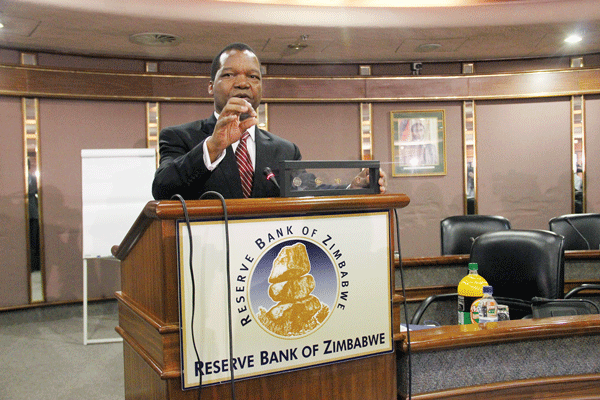
The Reserve Bank of Zimbabwe (RBZ) last week issued its first monetary policy statement (MPS) for 2021 where it committed to keeping a hawkish eye on exchange rate movements to ensure stability.
The tone was positive with the RBZ optimistic that the forecasted economic growth rate of 7,4% was achievable buttressed by both a strong agricultural season and balance of payment position, despite the downside risk posed naturally by the COVID-19 pandemic.
RBZ indicated that it will continue with its hawkish stance on maintaining exchange rates stability and ensure annual inflation closes the year at sub 10% levels.
There will be a continued focus on sustaining the foreign exchange auction and maximising its allocative efficiency to support projected economic growth.
At a total allotment figure of US$795 million since inception, the foreign currency auction system has arguably created a functional exchange rate for the country evidenced by the muting of violent price movements in the market as seen in the first half of 2020.
Parallel exchange rate premiums have eased from a high of 280% in the first half of 2020 to the current 43% in our estimates (in the MPS, the RBZ reports a premium of 20%).
The introduction of the second foreign exchange auction system specifically to cater for small to medium enterprises is in our view a good step towards creating greater convergence over time between formal and informal rates.
Settlement backlogs from the auction were a recurring issue in previous sessions and the RBZ has resolved to ensure that foreign currency allotments are concluded within 14 days from the date of auction.
- Chamisa under fire over US$120K donation
- Mavhunga puts DeMbare into Chibuku quarterfinals
- Pension funds bet on Cabora Bassa oilfields
- Councils defy govt fire tender directive
Keep Reading
Surrender requirements on exports have been largely driving inflows for the auction and the Apex bank made no indication of revising the export surrender ratio from the current 40%.
In our view, the country is positioned to report a positive trade balance in 2021 premised on further downward pressure on imports in light of a good agricultural season and a sustained positive exports performance — all of which point to an enhanced stability to sustain the foreign exchange auction system as long as discipline is maintained.
Weekly allocations have been edging up to the US$40 million mark.
Inflation development and outlook
The central bank has indicated that the slowdown in the headline CPI month-on-month inflation fell in line with targets coming in at below 5% by December 2020, whilst annual inflation was 1620 basis points above the forecasted year-end figure registering at 348,6%.
The slight jump in inflation rates in January (month-on-month inflation of 5,4% and annual inflation of 362,6%) which contrasted the overall downward trend we have been witnessing has been credited to the knock-on effect of the increase in international commodity prices and correction in pricing of rates and levies which are traditionally reviewed at the beginning of the year.
Going forward, the RBZ is targeting a month-on-month inflation rate of below 3% and deceleration of annual inflation to below 10% to year end 2021.
We believe that in line with the central bank’s sentiments and continued fiscal discipline, inflation will continue to decelerate.
However, domestic inflationary pressures will remain under the surface amidst shaky market confidence about the current equilibrium and possible lobbying by trade unions for further upward review of civil servants salaries.
Money supply rose 511% from $36 billion in January 2020 to $184 billion in December 2020 attributable to the impact of exchange rate movements on the 60% foreign currency component of deposits. Reserve money growth was below quarterly targets throughout 2020 as the central bank aggressively mopped up excess liquidity through open market operations. The outstanding open market operations savings bonds stood at $14,1 billion in December 2020 whilst reserve money was $18,7 billion.
The monetary policy committee has further applied brakes to neutralise excess liquidity on the market and keep a leash on speculative borrowing.
The policy rate has been reviewed upwards from 35% to 40% per annum with a view to prevent excess liquidity being channelled towards purchasing foreign currency, thus putting pressure on the exchange rate.
The interest rate on the medium-term bank accommodation (MBA) facility, which aims to support banks with productive sector funding requirements, has also been upped from 25% to 30% per annum whilst quarterly reserve money growth target has been trimmed down to 22,5% from 25%.
However, at present lending rates amidst a deceleration in month-on-month inflation, we may see commercial banks themselves becoming more bullish about returning to core business leading to a reversal in low deposit rates.
Earnings thus far have been driven by non-interest income with loan books remaining subdued and banks showing high liquidity ratios.
Limits on mobile banking transactions are maintained at $5 000 per transaction and $35 000 per week. However, the daily cash withdrawal limits for individuals have been raised to $2 000 and the bank announced its intention to bring a $50 note into circulation.
The monetary policy committee’s decision to maintain the current limits on mobile banking transactions will further prevent speculative activity on the parallel market which is positive for exchange rate stability.
Despite some negativity around the foreign exchange auction system, our view is that its introduction provided a much-needed devaluation, whilst SI185 allowing businesses to price in hard currency further enhanced confidence.
A disciplined approach to money supply growth and restrictions on mobile money platforms have all combined to bring a fragile stability within the monetary space which has reduced premiums between formal and parallel rates.
We are cautiously optimistic that inflation will remain on a downward trajectory, provided that the discipline displayed in 2020 is repeated in 2021. We do, however, expect the country to potentially overshoot the set inflation targets partly due to unpredictable external pressures on domestic pricing. We remain bullish on consumer names in the equities space as we see an upliftment in consumer liquidity and demand in this year despite COVID-19 impacts.











